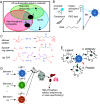Recent advances in nanoparticulate RNA delivery systems
- PMID: 38437569
- PMCID: PMC10945842
- DOI: 10.1073/pnas.2307798120
Recent advances in nanoparticulate RNA delivery systems
Abstract
Nanoparticle-based RNA delivery has shown great progress in recent years with the approval of two mRNA vaccines for Severe Acute Respiratory Syndrome Coronavirus 2 (SARS-CoV-2) and a liver-targeted siRNA therapy. Here, we discuss the preclinical and clinical advancement of new generations of RNA delivery therapies along multiple axes. Improvements in cargo design such as RNA circularization and data-driven untranslated region optimization can drive better mRNA expression. New materials discovery research has driven improved delivery to extrahepatic targets such as the lung and splenic immune cells, which could lead to pulmonary gene therapy and better cancer vaccines, respectively. Other organs and even specific cell types can be targeted for delivery via conjugation of small molecule ligands, antibodies, or peptides to RNA delivery nanoparticles. Moreover, the immune response to any RNA delivery nanoparticle plays a crucial role in determining efficacy. Targeting increased immunogenicity without induction of reactogenic side effects is crucial for vaccines, while minimization of immune response is important for gene therapies. New developments have addressed each of these priorities. Last, we discuss the range of RNA delivery clinical trials targeting diverse organs, cell types, and diseases and suggest some key advances that may play a role in the next wave of therapies.
Conflict of interest statement
Competing interests statement:Both R.L. and D.G.A. have extremely extensive sets of patents including many in the RNA delivery space. For some examples, see: D.G.A.: US Patent App. 18/080,299 (J.W. is also an author on this patent application) US Patent 11,608,412 US Patent 11,603,396 US Patent 11,459,304 R.L.: US Patent 11,279,928 US Patent 10,933,139.
Figures


References
-
- Moody E. R., Obexer R., Nickl F., Spiess R., Lovelock S. L., An enzyme cascade enables production of therapeutic oligonucleotides in a single operation. Science 380, 1150–1154 (2023). - PubMed
-
- Finn J. D., et al. , A single administration of CRISPR/Cas9 lipid nanoparticles achieves robust and persistent in vivo genome editing. Cell Rep. 22, 2227–2235 (2018). - PubMed
MeSH terms
Substances
Grants and funding
LinkOut - more resources
Full Text Sources
Other Literature Sources
Miscellaneous

